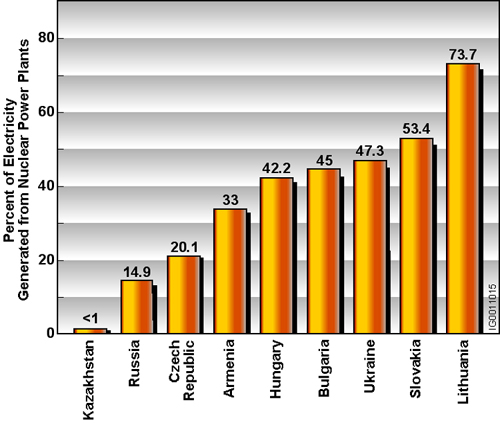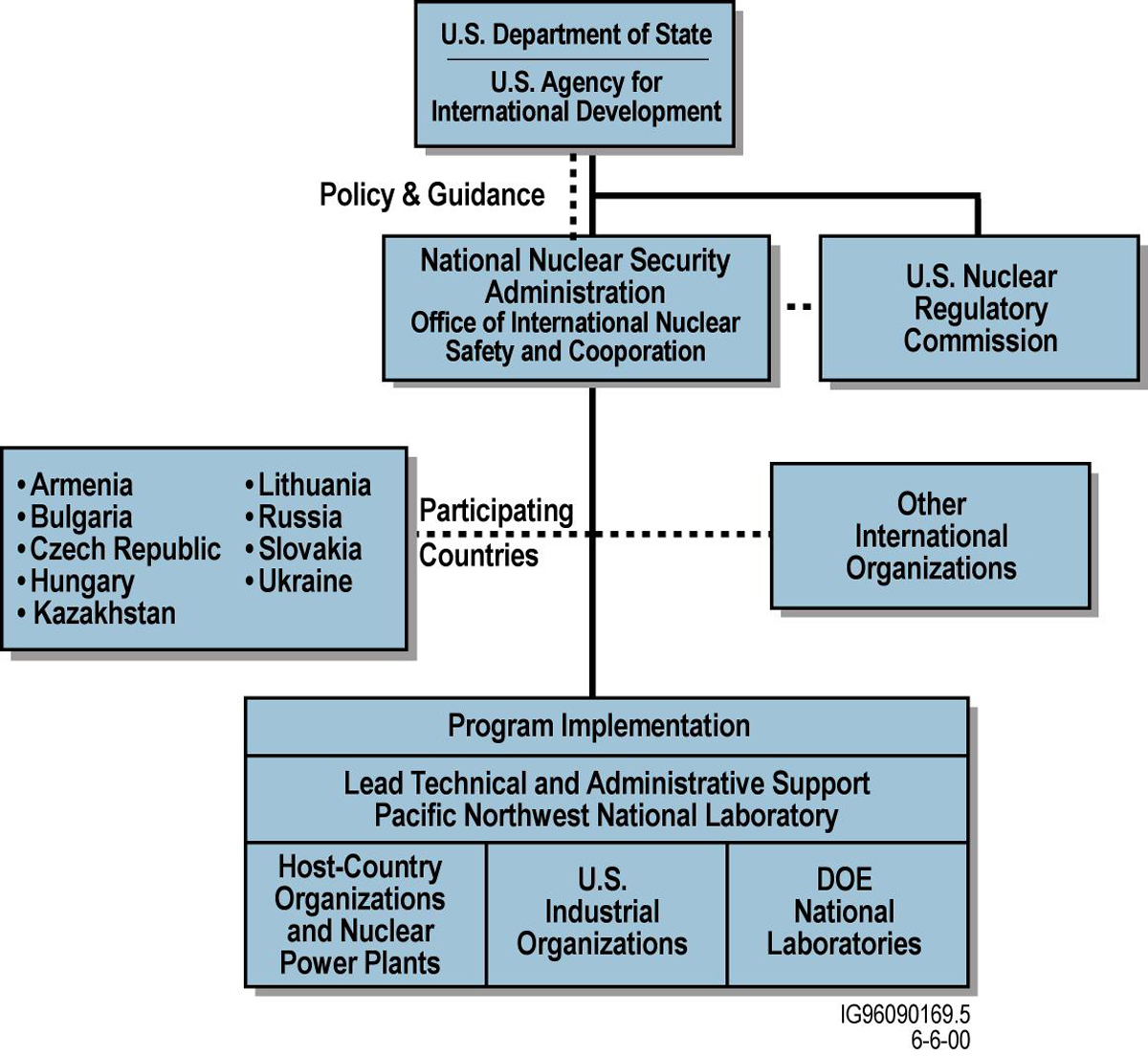 |
Program Overview
On this pageIntroduction
Background
Objectives
Program Elements
Reactor Types
Program Approach
Introduction
The U.S. Department of Energy manages a comprehensive program, in cooperation with partners in other countries, to reduce risks at all Soviet-designed nuclear power plants, except the Loviisa nuclear power plant in Finland. The Loviisa plant has been extensively modified by Finnish authorities to be consistent with accepted international safety requirements.
This program is conducted in cooperation with Armenia, Bulgaria, the Czech Republic, Hungary, Kazakhstan, Lithuania, Russia, Slovakia, and Ukraine (the host countries) in their efforts to make plant operations safer and build their own infrastructure to sustain safety improvements. These nuclear safety activities are promoting a lasting safety culture in the host countries that is consistent with international practices.
Background
The Chornobyl accident in 1986 alerted the world to safety issues at Soviet-designed reactors. The U.S. efforts originated in 1988, when the United States and the former Soviet Union signed a Memorandum of Cooperation in the field of civilian nuclear reactor safety.
In 1990, the U.S. Department of Energy began a modest program to improve operational safety at Novovoronezh nuclear power plant in Russia. This was followed in 1991 with initial efforts to improve safety at Bulgaria's Kozloduy plant. These first steps led to the development of the "Lisbon" safety initiative to enhance the operational safety of Soviet-designed reactors, reduce risks at the least-safe designs (RBMKs and VVER-440/230s), and enhance the capability of regulatory organizations. These goals were endorsed at the G-7 summit in Munich in July 1992, and in September of that year initial funding was provided under an interagency agreement between the U.S. Agency for International Development and the U.S. Department of Energy.
 |
| Percentage of electricity produced from nuclear reactors in host countries (2000) |
In 1993, at the G-7 summit in Vancouver, Canada, President Clinton pledged $100 million to Russia for nuclear safety improvements. Since that time, U.S. efforts have expanded to include urgently needed safety work at 22 nuclear power plants with 67 operating reactors in nine host countries. U.S. work is conducted in cooperation with similar programs initiated by the other G-7 countries-Canada, France, Germany, Italy, Japan, and the United Kingdom, as well as international organizations.
 |
| Relationships among participants in DOE's International Nuclear Safety Program |
DOE's program to reduce risk at Soviet-designed nuclear power plants is managed by its Office of International Nuclear Safety and Cooperation. Pacific Northwest National Laboratory provides technical and management support. Additional support is provided by other U.S. national laboratories, U.S. commercial organizations, and the nuclear power plants and scientific and engineering organizations in the host countries (see organization chart above).
Contracts have been placed with more than 600 U.S. commercial organizations to provide assistance in implementing program activities. In addition, working agreements have been established with 16 nuclear power plants and over 50 scientific institutions and government agencies in the host countries.
The work is conducted in accordance with the guidance and policies of the U.S. Department of State and U.S. Agency for International Development, in close collaboration with the U.S. Nuclear Regulatory Commission. The program is coordinated with work being funded by international agencies such as the European Bank for Reconstruction and Development/Nuclear Safety Account, International Atomic Energy Agency, Nuclear Energy Agency of the Organization for Economic Cooperation and Development, and other countries that are providing assistance through bilateral agreements.
Objectives
The following objectives were established for the support of host-country efforts to improve safety at Soviet-designed nuclear power plants:
- Improve the physical condition of plants and install needed safety equipment.
- Establish a nuclear safety culture in which safety takes priority over power production.
- Develop improved safety procedures and train operators in their use.
- Conduct safety assessments that meet international standards.
- Establish regional centers for training reactor personnel and develop simulators for training control room operators.
- Develop a regulatory and institutional framework for nuclear plant design, construction, and operation that is in keeping with international practices.
- Address the extraordinary problems at Chornobyl.
Program Elements
Projects to meet these objectives are organized under the following program elements:
Management and operational safety projects increase day-to-day operational safety by establishing safe operating procedures, training operators, and transferring safety maintenance technologies and training.
Engineering and technology projects reduce risks by upgrading safety system equipment of Soviet-designed nuclear power plants. Projects in this category are focused on improving fire safety, nuclear materials confinement, and reactor safety systems.
In-depth safety assessment projects improve the abilities of designers, operators, and regulators to assess the safety of their plants through the use of internationally accepted computer codes, standards, and methods.
Fuel cycle safety projects improve the handling and storing of reactor fuel.
Nuclear safety institutional and regulatory framework projects address the need for effective legal and regulatory systems in countries that operate Soviet-designed reactors.
Reactor Types
The 22 nuclear power plants participating in DOE's cooperative program include a total of 67 operating reactors. (This number was reduced to 66 when Chornobyl Unit 3 shut down on December 15, 2000.) Sixty of these reactors were built to two basic designs, the RBMK (boiling water, graphite-moderated, pressure-tube reactors) and the VVER (pressurized, light-water-cooled and -moderated reactors). The types of Soviet-designed reactors operating in the nine host countries are shown in the table below. Illustrations and descriptions of the basic reactor types are provided in Appendix A.
| Reactor Type | RBMK | VVER-440/230 | VVER-440/213 | VVER-1000 | LWRG-12 | BN-600 | BN-350 |
|---|---|---|---|---|---|---|---|
| Russia | 11 | 4 | 2 | 7 | 4 | 1 | |
| Ukraine | 1* | 2 | 11 | ||||
| Bulgaria | 4 | 2 | |||||
| Czech Republic | 4 | ||||||
| Hungary | 4 | ||||||
| Lithuania | 2 | ||||||
| Slovakia | 2 | 4 | |||||
| Armenia | 1 | ||||||
| Kazakhstan | 1** |
| BN LWGR RBMK VVER |
= = = = |
Breeder reactor. Light-water-cooled, graphite-moderated reactor. Boiling-water, graphite-moderated, pressure tube reactor. Pressurized, light-water cooled and moderated reactor. |
*Ukraine's final RBMK reactor, Chornobyl Unit 3, shut down on December 15, 2000, but decommissioning activities continue.
**Plant has been shut down since 1999, but no work has been carried out to begin decommissioning activities.
The RBMK design contains deficiencies that include a susceptibility to power instabilities and a lack of a modern containment system to prevent release of radionuclides to the environment. Inadequacies also exist in the emergency core-cooling systems, fire protection systems, and electronic control-and-protection systems.
There are three generations (models) of the VVER design-the VVER-440/230, the VVER-440/213, and the VVER-1000. The earliest, VVER-440/230, has no containment system and a marginal emergency core-cooling system. Inadequacies also exist in the back-up safety systems, fire-protection systems, and electronic control-and-protection systems.
The VVER-440/213 design is an enhanced version of the 230 model. It has an adequate emergency cooling system and a "bubbler condenser tower" that provides a measure of containment. Fire protection and electronic control-and-protection systems are inadequate.
The VVER-1000, the largest and newest model, meets most modern safety standards. It has an adequate emergency core-cooling system and a containment building. However, its fire protection and electronic control-and-protection systems have shortcomings.
Fourteen RBMK reactors are in operation in Lithuania, Russia, and Ukraine. (This number was reduced to 13 when Chornobyl Unit 3 shut down in December 2000.) Forty-seven VVER reactors operate in Armenia, Bulgaria, Czech Republic, Hungary, Russia, Slovakia, and Ukraine. Russia also has four small (12-MW electrical) light-water-cooled, graphite-moderated reactors and a 600-MW fast breeder reactor. Kazakhstan's one 350-MW fast breeder reactor was shut down in March 1999.
Inadequacies in Reactor Operation
In addition to design deficiencies, the Chornobyl nuclear power plant accident dramatically emphasized that serious inadequacies existed in how Soviet-designed reactors are operated. Procedures for routine operations and abnormal conditions were not consistent with internationally accepted practices. Considerable progress has been made to improve operating procedures. In addition, training of nuclear power plant managers and operators needed to be upgraded to a more systematic approach. To meet this need, training centers have been established at the Balakovo plant in Russia and at the Khmelnytskyy plant in Ukraine, and training technology is being transferred to all host countries.
Successful Y2K Transition
In 1999, DOE's Y2K assistance program helped ensure that all Soviet-designed plants in the program experienced a smooth "rollover" into the new millennium. Coordinated with other international assistance and host-country Y2K efforts, this program helped alert countries with Soviet-designed nuclear power plants to Y2K computer vulnerabilities through workshops and seminars. In addition, DOE-sponsored projects were instrumental in identifying, remediating, and planning for Y2K problems.
DOE's Y2K assistance to Soviet-designed nuclear power plants included provision of automated scanning tools to locate problems in software and replacement hardware at plants in Russia, Ukraine, and other host countries. Plant staffs carried out the actual remediation efforts as well as the contingency planning. Without U.S. assistance, the risk of Y2K problems at these plants would have been much greater, and some plants likely would have been forced to shut down for the Y2K rollover. When the new millennium had dawned, all of the plants in the program had made a successful transition into the new century.
Program Approach
DOE's cooperative assistance efforts and other international efforts alone cannot resolve the safety deficiencies at all Soviet-designed nuclear power plants. Therefore, a goal of DOE's efforts is to help host countries develop their own capability to more safely operate and regulate nuclear power plants.
To achieve this goal, a "pilot plant" approach is being used. One or two pilot or lead plants, or in some cases a group of selected plants, receive training, technology, and physical improvements. A sufficient number of pilot plant projects will be completed within each key area to serve as a safety improvement model for all host countries. As an integral part of each project, technology and training are provided to equip each host country to extend improvements independently. Using their own resources, host countries are expected to capitalize on the momentum established at the pilot plants to extend improvements to other facilities. In fact, the host countries continue to make safety improvements with their own resources.